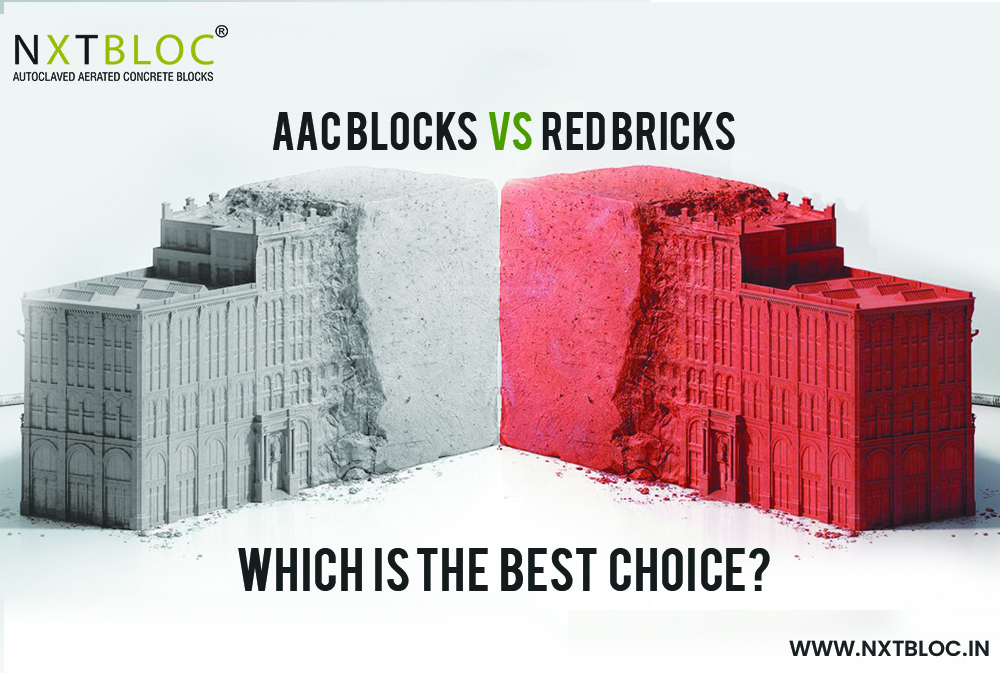AAC blocks vs red brick: which to choose? This is a major question that we look upon while planning for construction. Walls are built from bricks. The durability and strength of the wall and structure depend on the quality of the brick. For a longer period of time, red brick is the most common brick used in masonry. This is due to durability, low cost, affordability, comfort, etc.
As the population grows, so does the demand for red bricks. Fertilizers, which are already in short supply in India, are being used to meet the demand for red brick. In addition, a shortage of skilled labor and an increase in the amount of fuel increase the cost of bricks. For these reasons, research on alternative brick options is underway and a concrete block is a solution.
There are various types of cement blocks on the market today and the most common of these is AAC. Fly ash is used on the unit. Fly ash is a by-product and very difficult to remove. The use of fly ash to clean the unit is not harmful to the environment. The block has high strength and durability, and now it has become well known for its environmental factor.
Major differences between AAC blocks and red bricks.
-
Compressive Strength:
Autoclaved aerated concrete blocks (AAC) are produced in specialized factories, designed and developed at the same time. On the other hand, red brick is easy to find in all areas and therefore lacks compressive strength compared to AAC blocks. AAC blocks are specially designed to be more resistant to compression loads. Red bricks have a compressive strength of 2.5 to 3.5 N / mm2, while AAC blocks provide a compressive strength of 3 to 4.5 N / mm2.
-
Durability:
Autoclaved aerated concrete blocks (AAC) are specially designed to be stronger and more homogeneous, which significantly strengthens the entire structure. Red bricks are much more fragile than AAC blocks, which can lead to significant waste as well as general construction defects. By using AAC blocks, construction companies can increase the lifespan of the buildings/establishments. These blocks also provide limited maintenance and repair needs.
-
Utility:
Autoclaved aerated concrete blocks (AAC) are lightweight and extremely convenient to use, enabling increased use in construction sites. On the other hand, red clay brick is heavy, thick and ineffective in large volumes. As the AAC blocks are thinner, the available carpet area in the building/establishments increases.
-
Workability:
Autoclaved aerated concrete blocks (AAC) are lighter and stronger, provide superior workability in all construction projects and require less labor. This ultimately reduces labor costs, resulting in significant savings on a large scale. When using AAC blocks, the number of joints is reduced, which again results in significant mortar savings as well as an increase in construction speed compared to red bricks.
-
Sustainability:
The red brick is not as environmentally friendly as autoclaved aerated concrete blocks (AAC). A square foot of red brick wall can consume about 25 kg of topsoil, which has long-term negative effects on the environment. While AAC blocks are made of fly ash, which is a by-product of waste from thermal power plants, which is usually non-toxic in nature. The manufacturing process ensures that all waste from the cutting process can be recycled for reuse. The production of AAC blocks does not emit significant amounts of pollutants.
Some notable features:
-
Lightweight:
Autoclaved aerated concrete blocks (AAC) are 3-4 times lighter than red bricks, which makes them economical and easy to transport.
-
Fire Resistance:
Autoclaved aerated concrete blocks (AAC) can provide fire resistance for up to 4 hours, depending on the thickness of the walls. On the other hand, red brick can only provide fire resistance for about 2 hours.
-
Sound Insulation:
Autoclaved aerated concrete blocks (AAC) provide sound insulation of approximately 42 dB, blocking out all significant noise and interference, and therefore are a better choice compared to red bricks.
-
Thermal Insulation:
Autoclaved aerated concrete blocks (AAC) offer excellent thermal insulation properties for buildings/blocks, directly contributing to savings in heating, ventilation and air conditioning costs by almost 25-30%, while red-brick provides very little or no thermal insulation.
-
Earthquake Resistance:
Unlike red brick, autoclaved aerated concrete blocks (AAC) are specially designed to withstand seismic activity, making them ideal for construction projects.
-
Pest Resistance:
The autoclaved aerated concrete blocks (AAC) are made from inorganic materials and are highly resistant to termites and other common pests. Helps to reduce the cost of long-term maintenance of buildings projects, unlike red bricks.
-
Water Penetration:
Red bricks usually absorb a lot of water, which limits their use. Autoclaved aerated concrete blocks (AAC) absorb up to 10% water by weight, making them ideal for any construction.
-
Storage:
Autoclaved aerated concrete blocks (AAC) are easily available no matter what season it is and do not require special storage on the construction sites. For red bricks, the rainy season is a serious problem requiring special storage and handling.
Conclusion
Autoclaved aerated concrete blocks (AAC) or red brick, both play an important role in the construction industry. As mentioned above, red bricks are made from natural soil and can cause long-term erosion of the topsoil. On the other hand, AAC units are environmentally friendly and sustainable in nature, which not only helps to protect the environment but also contributes to cost and energy savings and ensures greater durability. Considering these differences between autoclaved aerated concrete blocks (AAC) and red brick, you can choose the right material for your next construction plan.
